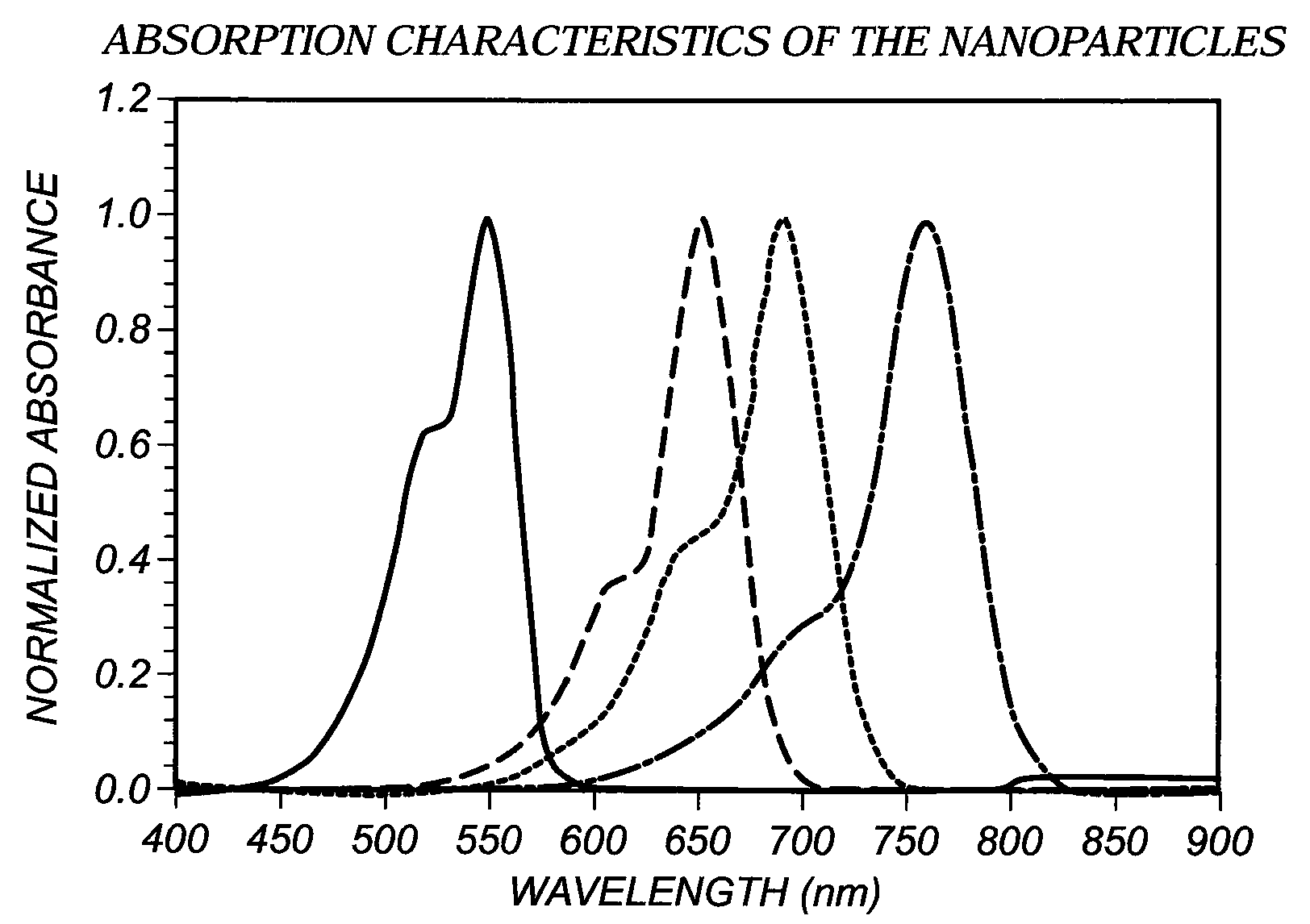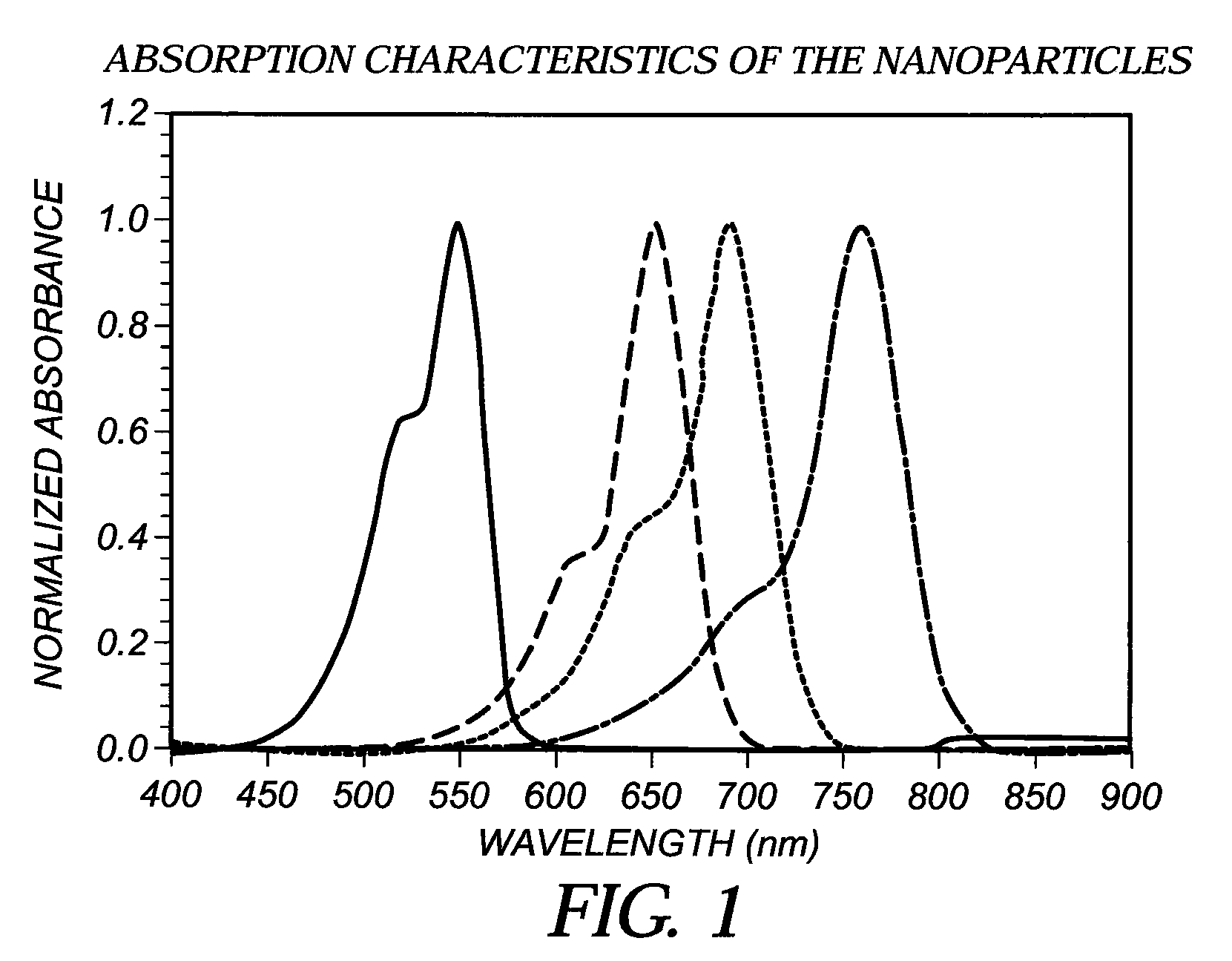Fluorescence resonance energy transfer detection with nanoparticles for in vitro and in vivo applications
a fluorescence resonance and nanoparticle technology, applied in the field of fluorescence resonance energy transfer detection with nanoparticles for in vitro and in vivo applications, can solve the problems of low signal-to-noise ratio, inability to achieve sufficient stability of qds to avoid becoming toxic, and many limitations of conventional near-infrared fluorescence probes
- Summary
- Abstract
- Description
- Claims
- Application Information
AI Technical Summary
Benefits of technology
Problems solved by technology
Method used
Image
Examples
example 1
Preparation of Amine-Terminated Polyethylene Glycol Methacrylate Hydrochloride
[0056]
[0057]Polyethyleneglycol dimethacrylate (Aldrich, Mn=875, 335 g) was mixed with 100 ml of methanol and treated with cysteamine (Aldrich, 5.8 g) and diisopropylethylamine (Hunigs base) and was stirred at room temperature for 2 days and concentrated using a rotary evaporator. The residue was taken up in 1 L of ethyl acetate and extracted with aqueous 10% HCl. The aqueous layer was collected and made basic by the addition of 50% aqueous sodium hydroxide followed by extraction with ethyl acetate. The organic layer was dried over MgSO4, filtered and concentrated. The residue was taken up. This material was washed with fresh diethyl ether, which was decanted. The residue was concentrated using a rotary evaporator to give 37 g of the desired product as the hydrochloride salt. The material was characterized by NMR spectroscopy, as follows: H-NMR (300 MHZ, CDCl3): D 1.18 (d, 3H), 1.93 (bs, 3H), 2.04 (bs, 2H),...
example 2
Preparation of Particle Comprised of Methoxyethyl Methacrylate (45% w / w), Divinylbenzene (4%), Ethylstyrene (1%), and Amine-Terminated Polyethylene Glycol Methacrylate Hydrochloride of Example 1 (50%)
[0058]A 500 ml 3-neck round bottomed flask was modified with Ace #15 glass threads at the bottom and a series of adapters allowing connection of 1 / 16 inch ID Teflon tubing. The flask (hereafter referred to as the “header” flask) was outfitted with a mechanical stirrer, rubber septum with syringe needle nitrogen inlet. The header contained methoxyethyl methacrylate (5.63 g), divinylbenzene (0.63 g, mixture of isomers, 80% pure with remainder being ethylstyrene isomers), amine-terminated polyethylene glycol ether methacrylate hydrochloride (6.25 g, Mn=940). A IL 3-neck round bottomed flask outfitted with a mechanical stirrer, reflux condenser, nitrogen inlet, and rubber septum (hereafter referred to as the “reactor”) was charged with 2,2′-azobis(N,N′-dimethyleneisobutyramidine) dihydrochl...
example 3
Preparation of Dye 4
[0059]This dye was prepared using 2,3,3-trimethyl-1-dodecyl-3H-Indolium perchlorate (4.28 g, 10 mmol) and the dianil (1.4 g, 5 mmol) in 40 mL of acetic anhydride containing triethylamine (1.5 g, 15 mmoles). The reaction time was 5 minutes. The reaction was cooled to 25° C. and poured into 2 liters of ice water with vigorous stirring. The water was decanted and the oil was dissolved in 100 mL of 80 / 20 dichlomethane-methanol. The material was chromatographed on a silica gel column eluting with 80 / 20 dichlomethane-methanol. Evaporation of the solvent after drying with anhydrous magnesium sulfate afforded pure dye (4 g, 32% yield), with absorption maximum 747 nm in methanol with extinction coefficient of 220,020.
PUM
| Property | Measurement | Unit |
|---|---|---|
| Fraction | aaaaa | aaaaa |
| Percent by mass | aaaaa | aaaaa |
| Size | aaaaa | aaaaa |
Abstract
Description
Claims
Application Information
 Login to View More
Login to View More - R&D
- Intellectual Property
- Life Sciences
- Materials
- Tech Scout
- Unparalleled Data Quality
- Higher Quality Content
- 60% Fewer Hallucinations
Browse by: Latest US Patents, China's latest patents, Technical Efficacy Thesaurus, Application Domain, Technology Topic, Popular Technical Reports.
© 2025 PatSnap. All rights reserved.Legal|Privacy policy|Modern Slavery Act Transparency Statement|Sitemap|About US| Contact US: help@patsnap.com



